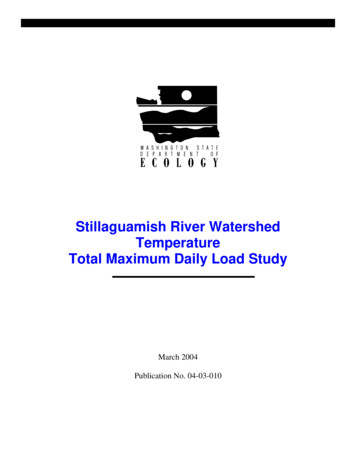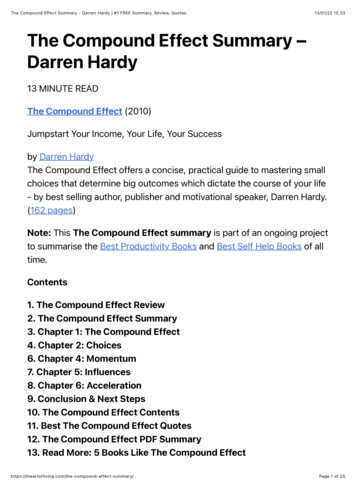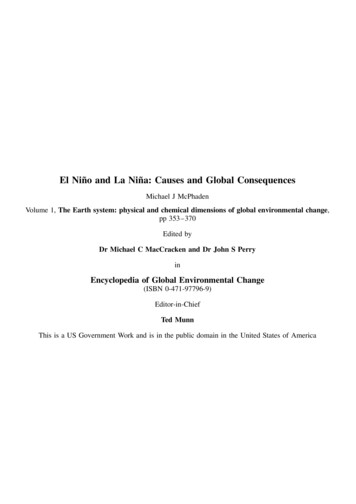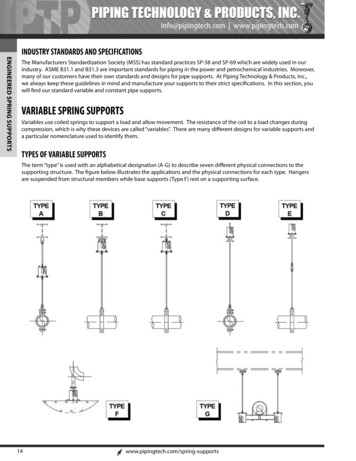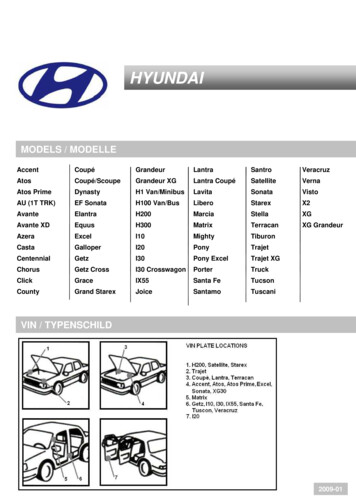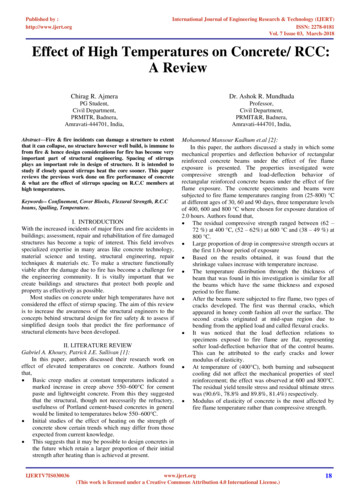
Transcription
International Journal of Engineering Research & Technology (IJERT)ISSN: 2278-0181Vol. 7 Issue 03, March-2018Published by :http://www.ijert.orgEffect of High Temperatures on Concrete/ RCC:A ReviewChirag R. AjmeraDr. Ashok R. MundhadaPG Student,Civil Department,PRMITR, Badnera,Amravati-444701, India,Professor,Civil Department,PRMIT&R, Badnera,Amravati-444701, India,Abstract—Fire & fire incidents can damage a structure to extentthat it can collapse, no structure however well build, is immune tofrom fire & hence design considerations for fire has become veryimportant part of structural engineering. Spacing of stirrupsplays an important role in design of structure. It is intended tostudy if closely spaced stirrups heat the core sooner. This paperreviews the previous work done on fire performance of concrete& what are the effect of stirrups spacing on R.C.C members athigh temperatures.Keywords-- Confinement, Cover Blocks, Flexural Strength, R.C.Cbeams, Spalling, Temperature.I. INTRODUCTIONWith the increased incidents of major fires and fire accidents inbuildings; assessment, repair and rehabilitation of fire damagedstructures has become a topic of interest. This field involvesspecialized expertise in many areas like concrete technology,material science and testing, structural engineering, repairtechniques & materials etc. To make a structure functionallyviable after the damage due to fire has become a challenge forthe engineering community. It is vitally important that wecreate buildings and structures that protect both people andproperty as effectively as possible.Most studies on concrete under high temperatures have notconsidered the effect of stirrup spacing. The aim of this reviewis to increase the awareness of the structural engineers to theconcepts behind structural design for fire safety & to assess ifsimplified design tools that predict the fire performance ofstructural elements have been developed.II. LITERATURE REVIEWGabriel A. Khoury, Patrick J.E. Sullivan [1]:In this paper, authors discussed their research work oneffect of elevated temperatures on concrete. Authors foundthat, Basic creep studies at constant temperatures indicated amarked increase in creep above 550–600 C for cementpaste and lightweight concrete. From this they suggestedthat the structural, though not necessarily the refractory,usefulness of Portland cement-based concretes in generalwould be limited to temperatures below 550–600 C. Initial studies of the effect of heating on the strength ofconcrete show certain trends which may differ from thoseexpected from current knowledge. This suggests that it may be possible to design concretes inthe future which retain a larger proportion of their initialstrength after heating than is achieved at present.IJERTV7IS030036Mohammed Mansour Kadhum et.al [2]:In this paper, the authors discussed a study in which somemechanical properties and deflection behavior of rectangularreinforced concrete beams under the effect of fire flameexposure is presented. The properties investigated werecompressive strength and load-deflection behavior ofrectangular reinforced concrete beams under the effect of fireflame exposure. The concrete specimens and beams weresubjected to fire flame temperatures ranging from (25-800) Cat different ages of 30, 60 and 90 days, three temperature levelsof 400, 600 and 800 C where chosen for exposure duration of2.0 hours. Authors found that, The residual compressive strength ranged between (62 –72 %) at 400 C, (52 – 62%) at 600 C and (38 – 49 %) at800 C. Large proportion of drop in compressive strength occurs atthe first 1.0-hour period of exposure Based on the results obtained, it was found that theshrinkage values increase with temperature increase. The temperature distribution through the thickness ofbeam that was found in this investigation is similar for allthe beams which have the same thickness and exposedperiod to fire flame. After the beams were subjected to fire flame, two types ofcracks developed. The first was thermal cracks, whichappeared in honey comb fashion all over the surface. Thesecond cracks originated at mid-span region due tobending from the applied load and called flexural cracks. It was noticed that the load deflection relations tospecimens exposed to fire flame are flat, representingsofter load-deflection behavior that of the control beams.This can be attributed to the early cracks and lowermodulus of elasticity. At temperature of (400 C), both burning and subsequentcooling did not affect the mechanical properties of steelreinforcement; the effect was observed at 600 and 800 C.The residual yield tensile stress and residual ultimate stresswas (90.6%, 78.8% and 89.8%, 81.4%) respectively. Modulus of elasticity of concrete is the most affected byfire flame temperature rather than compressive strength.www.ijert.org(This work is licensed under a Creative Commons Attribution 4.0 International License.)18
Published by :http://www.ijert.orgInternational Journal of Engineering Research & Technology (IJERT)ISSN: 2278-0181Vol. 7 Issue 03, March-2018 Concrete with silica fume suffered the most underincreased exposure temperature below 800oC.High-strength concrete showed 90% drop in its strengthsonce exposed to 1000oC irrespective of the type of bindermaterials used.Modulus of elasticity of high-strength concrete was lesssensitive to the maximum temperature than eithercompressive or tensile strength.Ultrasonic pulse velocity measurement could be used toestimate the temperature-related damage in concrete.Fig.1 Drop in elastic modulus with temperatureS. C. Chakrabarti, K. N. Sharma et al. [3]:The authors conducted an extensive test program forassessing the residual strength of concrete after fire. Theconclusions of the test were, The authors concluded that the concrete actually gainedsome strength between 100 to 300 C in the presence ofsiliceous & carbonaceous aggregates. Some other researchers too have reported thisphenomenon, but they faced criticism then support. As per the authors, concrete didn't lose much of itsstrength up to 500 C & in fact regained 90% of loststrength up to this temperature after about a year. Concrete cubes heated beyond 800 C for 4 hours startedcrumbling after 2-3 days.The theory of fire affected concrete regaining some of itsstrength with time is not an established one & lacks supportingevidence.R. Sri Ravindrarajah, R. Lopez et al. [4]:In this paper, authors discussed about the degradation of thestrengths and stiffness of high-strength concrete in relation tothe binder material type. As per the authors high strengthconcrete mixtures generally have low water to cement ratio andhigh binder material content. They used high-water reducingadmixture (super plasticiser) to achieve workable concrete atlow water cement ratio which resulted in producing concretehaving its 28-day compressive strength well over 100MPa. Fortesting they used four types of mixes having varying bindermaterials. Mixes 1 and 2 consisted of 565 kg/m3 of generalpurpose cement, general blended cement having 62% blastfurnace slag content. In Mix 3, 20% of the Type GP cementwas replaced with low-calcium fly ash (115 kg/m3). Mix 4contained 565 kg/m3 of general purpose cement and 40 kg/m3of condensed silica fume. For all four mixes, the water tobinder ratio was kept at 0.30. Concrete test specimens wereheated at temperatures of 200oC, 400oC, 600oC, 800oC, and1000oC. The results were, High-strength concrete, independent of the binder materialtype used, experienced weight loss and the relationshipbetween the weight loss and maximum temperature wasnon-linear. Compressive and tensile strengths showed noticeablelosses (above 15%) even at the temperature of 200 oC,however the elastic modulus dropped marginally by about5%.IJERTV7IS030036Fig.2 Residual tensile strength of concrete after high-temperature exposureDattatreya, B. Balakrishna Bharath [5]:In this paper author did a research work on studying theimpact of fire on reinforcement provided in R.C.C structures ofvarious types of buildings which are under blast or fire. TheBehavior of Steel Reinforcement at various elevatedtemperatures from 100 C to 1000 C was studied. Thespecimens for testing were TMT bar of 12mm diameter. 20bars were cut to 30 cm size. Then the specimens were tested forthe mechanical properties using UTM before heating at normalroom temperature and the properties were tabulated.10specimens each were heated in the electric furnace at 100 ,300 , 600 , 900 C and 1000 C for an hour without anyinterference. After heating, out of 10 specimens for eachtemperature 5 samples were quenched in cold water for rapidcooling and the other 5 were kept aside for normal cooling atatmospheric temperature. These specimens later were tested formechanical properties with UTM. The authors concluded that, Ductility of quickly cooled reinforced bars after heatingto high temperature of 1000 C decreased which couldbe dangerous for a structure. Significant change in ductility was observed at hightemperatures & near ultimate load. A major problem caused by high temperatures wasspalling of concrete i.e. separation of concrete massfrom concrete element which resulted in the exposure ofsteel reinforcement directly to high temperatures. If the duration and the intensity of fire are higher, theload bearing decreased to the extent of the applied loadresulting in collapse of structure.www.ijert.org(This work is licensed under a Creative Commons Attribution 4.0 International License.)19
Published by :http://www.ijert.orgInternational Journal of Engineering Research & Technology (IJERT)ISSN: 2278-0181Vol. 7 Issue 03, March-2018 Fig.3 Elongation with rising temperaturesA. R. Mundhada et.al [6]:The authors performed an experiment on effect ofconfinement on fire performance. 108 R.C.C beams (36 eachfor concrete grades M 30, M 25 & M 20) of size 100*100*450were cast. The beams were reinforced with 2 no’s 8Y bars attop & bottom. Half the beams had closely spaced stirrupswhereas the remaining had sparsely spaced 5mm Ø stirrups.After the beams were cured for 28 days, they were heated at30 C, 200 C, 350 C, 500 C, 650 C, and 800 C. After heating,specimens were air-cooled at room temperature for 24 hours.After cooling, various non-destructive tests like Thermogravimetric analysis, Schmidt Hammer Test & UV PulseVelocity Test were carried out. Finally, all the specimens werebroken in UTM by applying two-point loads to find out theflexural strength.Fig. 4 Graph between temperature and % dropThe conclusions of the test conducted were, Up to 350 C, concrete remained unaffected quality wiseand strength wise. Strength lost was @10% or less. At 500 C, quality of concrete decreased, but remained fair& strength came down by 20-25%. Structure/membersremained serviceable but factor of safety decreased.Affected member would require minor repairs to becomeserviceable again. At 650 C, strength decrease was noticeable and comedown by a third. At 800 C, concrete lost most of its strength & affectedportion would require replacement. Strength of the confined (closely spaced stirrups) beamwas almost always higher in absolute terms, as comparedto the unconfined (less stirrups) beam. At the same time,IJERTV7IS030036the percentage drop in strength & quality in case of aconfined section was always higher vis-à-vis itsunconfined alter ego.Judicious stirrup spacing would be required for resistingforces like earthquake, but too closely spaced stirrups werenot desirable from fire point of view.Rahul P. Chadha, Ashok R. Mundhada [7]:In this experiment, the authors studied effect of fire onflexural strength of reinforced concrete beams. 42 beams of c/s150*150*700mm were cast. Six specimens were tested for theFlexural strength using UTM before heating at normaltemperature and twelve specimens (6 specimen of 25mm clearcover & 6 specimen of 30mm clear cover) each were heated inthe electrical furnace at 550 C for 1 hour and 2 hourrespectively without any disturbance & same procedure wasrepeated for 12 specimens each for 750 C and 950 C. 3specimens were cooled at normal temperatures, 3 but werequenched with water & rapidly cooled. Thermogravimetrictests were carried out & finally the beams were tested forstrength under UTM. The conclusion was, Up to 550 C, the weight loss for RCC was negligible &the flexural strength reduced by 1/3rd. No cracking,spalling or scaling was observed up to this stage. The fireaffected structure up to this point would only require rapidcooling & repairs. At @ 750 C, there was a further drop in weight & flexuralstrength, cracks did appear but there was hardly anyspalling or scaling. The fire affected structure at this pointwould require rapid cooling & retrofitting. Factor of safetywould come down, but the structure would remainserviceable. Beyond this stage, all the parameters dropped drastically.Weight loss at 950 C exceeded 10%, flexural strengthcame down by 2/3rd, major cracking, spalling & scalingwas observed. The fire affected portion at this stage would requirereplacement. Greater cover & faster cooling would provide relief.Ashok R. Mundhada, Arun D. Pophale [8]:In this paper author studied effect of high temperatures oncompressive strength of concrete. 90 concrete cubes of 150 mmsize, divided equally over three different grades of design mixconcrete viz. M 30, M 25 & M 20 were cast. After 28 days’curing & 24 hours’ air drying, the cubes were subjected todifferent temperatures in the range of 200 C to 800 C, for twodifferent exposure times viz. 1 hour & 2 hours in an electricfurnace. The heated cubes were cooled at room temperature for24 hours & then subjected to cube compressive strength test.Mix design was carried out using the Ambuja method ofdesign. The conclusions of the test were, Up to 350 C, concrete remained almost unaffected inappearance & strength. At 500 C, quality of concrete came down slightly &strength too came down. Affected members remainedserviceable although the factor of safety would comedown. At 650 C, the fall in concrete quality & strength became acause for concern. Major retrofitting might be required.www.ijert.org(This work is licensed under a Creative Commons Attribution 4.0 International License.)20
Published by :http://www.ijert.org International Journal of Engineering Research & Technology (IJERT)ISSN: 2278-0181Vol. 7 Issue 03, March-2018Beyond 650 C, concrete lost most of its strength and wasnot structurally stable & it might require replacement.Higher exposure time resulted in greater damage.Higher grade concrete performed better in absolute terms.Fig. 5 % drop in compressive strength after 2 hrsPoorna S, Reshma Prasad [9]:In this study the thermal behaviour of reinforced concreteslab exposed to fire was studied. The paper mainly focused onthe percentage deflection of RC slab when exposed to elevatedtemperature. The behaviour of one-way reinforced concreteslabs exposed to fire was investigated using ANSYS 14.5.11.Simply supported one way reinforced concrete slab modelswere considered with three different parameters namely: M 25,M 70 and M 100 grades of concrete, different covers of 30mm,40mm and 50mm with grade of steel 415 N/mm2. The size ofthe slab panel was, 3300mm x 1200mm x 200mm. Thetemperature applied on the slab was based on the ISO 834 firecurve. A pressure of 0.1 N/mm2 was applied on the slab. Thedeflection was noted and studied.Table 1 Interpretation of results based on coverThe conclusion of this study was,The normal strength concrete M 25 and high strengthconcrete M 70 and M 100 exhibited linear response. The deflection of slab decreased as the cover wasincreased. This was because concrete’s enhanced capacityto resist fire. From the above analysis it was concluded that M 100 witha cover of 50 mm showed minimum deflection whenexposed to high temperature and pressure. IJERTV7IS030036 Maximum deflection was shown by M 25 grade with 30mm cover at high temperature and pressure.M. M. Hossain, N Apu et.al [10]:This paper deals with the behaviour of reinforced concretebeams exposed to fire at three different temperature levels. Forthis purpose, eight RCC beam samples were cast with identicalcross section. The materials used for the casting of the beamslike rebar and concrete were tested. Two reference beamspecimens were tested for flexural strength that were notsubjected to fire. The other six specimens two in each groupwere subjected to fire of levels 400 C, 600 C and 800 Crespectively for an exposure period of 2 hours which were thenallowed to cool naturally up to room temperature. Thenflexural strength of all the specimens was measured by anUTM and the results were compared with the two unburntbeams. The conclusion was, In general, majority of fire damaged RCC structures wererepairable. But the observation of effect of elevatedtemperature at 800 C on the reinforced concrete beamsshowed that there was a significant reduction in flexuralstrength. The cracking load for flexure for beams exposed to fire at400 C & 600 C for 2 hours declined by about 35.46% and57.77% respectively with respect to unburnt beams. But for 800 C there was a significant decrease in flexuralcracking load by about 75.44% which was alarming. The ultimate strength for beams exposed to fire at 400 C,600 C & 800 C for 120 minutes were less than that for thereference beam by about 16.71%, 31.18% & 44.05%respectively. To minimize the effect of temperature of 400 C,immediate quenching and minor retrofitting wasrecommended. For 600 C temperature, immediate repairing wasprescribed to help regain strength. For 800 C of fire effect, member replacement wassuggested.K. Thamaraiselvan, V. Jeevanantham et.al [11]:Authors carried out an experimental program to assess theresidual compressive strength of cube specimens. This studyspecifically addressed three types of concretes viz. normal,high strength and fly ash concrete. These specimens weretested in two separate condition states. The first representingair-cooled state involves heating the specimen to the requiredtemperature for prescribed duration and air cooled to the roomtemperature. Phase two involves heating the specimen to therequired temperature for the prescribed duration andimmediately cooled to the room temperature by immersing it inthe water (called water quenched). The strength and stiffnessdegradation of concretes for various grades has been studiedand compared with the similar studies carried by otherresearchers. The conclusion of research work was, Weight reduction was marginal at 200 C.At higher temperatures, the reduction was observed to behigher. About 8% weight loss was observed in highstrength concrete specimens at 1000 C.www.ijert.org(This work is licensed under a Creative Commons Attribution 4.0 International License.)21
Published by :http://www.ijert.org International Journal of Engineering Research & Technology (IJERT)ISSN: 2278-0181Vol. 7 Issue 03, March-2018At 500 C sudden explosive spalling was observed in fewhigh strength concrete specimens.For specimens exposed to 200 to 400o C, the averagereduction of compressive strength was 20% and 25%respectively.The reduction was found to be more in high strengthconcrete specimens. At 600 and 800C the residual strengthwas observed to be around one fourth of its originalcapacity.Further the rate at which the strength reduced wascomparatively more in high strength concrete specimensthan other types.The performance of fly ash concrete exposed to hightemperature was comparatively better than all the threetypes of concrete.III. DISCUSSIONThis paper presents a review of various research works carriedout on effect of fire on concrete. It becomes clear, no matterhow well is the structure designed, it is not safe from fire.Concrete and temperature are directly related to each other,higher the temperature, higher the damage.The theory of fire affected concrete regaining some of itsstrength with time, as propounded by Chakrabarti & Sharma[3] is not an established one & lacks supporting evidence.Concrete’s performance under fire is robust & up to 500o C,it only requires minor repairs. Stirrups spacing is veryimportant in designing the structure for earthquake. Closelyspaced stirrups leading to better confinement are beneficial forstructural members. However A. R. Mundhada et al. [6],suggest that during the event of fire, closely spaced stirrupsmay heat the core of structure sooner and hence may lead tofaster degradation of concrete. Since their unique study wasperformed on leaner members, it needs further exploration withthicker beam specimens.REFERENCESGabriel A. Khoury, Patrick J.E Sulliva, “The effect of elevatedtemperatures on Concrete”, Fire Safety Journal, Volume 13, Issue 1, 7April 1988, pp 69-72.[2] Mohammed Mansur Kadhum, “The fire endurance of reinforced concretebeams”, Babylon ed edition7/paper ed7 14.doc[3] S. C. Chakrabarti, K. N. Sharma, Abha Mittal, “Residual strength inconcrete after Exposure to elevated temperatures”, The Indian ConcreteJournal, December 1994, pp. 713-717.[4] R. Sri Ravindrarajah, R. Lopez, H. Reslan “Effect of Elevatedtemperature on the properties of High strength concrete containingcement supplementary materials”. 9th International Conference onDurability of Building Material & Components, 17-20th March 2002,Paper 81, 8 pages, Rotterdam, Netherlands.[5] A. Dattatreya & B. Balakrishna Bharath, “Impact of Fire onReinforcement Provided in R.C.C Structures of Buildings”, IJIRSETJournal, Volume 6, Issue 2, Feb-2017, pp 4-9.[6] Prof. A. R. Mundhada & U. G. Project batch, “Experimental studies onEffect of Confinement on reinforced concrete at elevated temperatures”,Bachelor of Engineering project 2015-2016, Prof Ram Meghe Institute ofTechnology & Research (P.R.M.I.T&R), Badnera.[7] Rahul P. Chadha, A R. Mundhada, “Effect of fire on flexural strength ofreinforced concrete beam”, International Journal of Engineering ResearchTechnology (IJERT) Volume 1, Issue 3, May-2012, pp 1-6.[8] Ashok R. Mundhada, Dr. Arun D. Pophale, “Effect of High Temperatureon Compressive Strength of Concrete”, IOSR Journal of Mechanical andCivil Engineering (IOSR-JMCE), Volume 12, Issue 1 Ver. II (Jan- Feb.2015), pp 66-70.[9] Poorna S, Reshma Prasad, “Effect of Fire on RC Slab”, IJIRST –International Journal for Innovative Research in Science &Technology,Volume 3, Issue 04, Sep -2016, pp 179-183.[10] M. M. Hossain, N Apu, U. H Sumaiya & Mahmood, “Testing of RCCBeams Exposed to Various Burning Temperatures”, Proceedings of the3rd International Conference on Civil Engineering forSustainableDevelopment (ICCES2016),12-14 Feb -2016, pp 703-706, Khulna,Bangladesh.[11] K. Thamaraiselvan, V. Jeevanantham, A. Parthiban, “Experimental Studyon Strength Reduction Factor in Concrete Specimen Subjected toHigh Temperature”, IOSR Journal of Mechanical&CivilEngineering(IOSR-JMCE) Volume 14, Issue 3 Version 7 (MayJune 2017), pp 60-64.[1]IV. CONCLUSIONEffect of stirrup spacing on performance of a structuralmember under fire is a least explored area & needs s work is licensed under a Creative Commons Attribution 4.0 International License.)22
subjected to fire flame temperatures ranging from (25 Keywords-- Confinement, Cover Blocks, Flexural Strength, R.C.C beams, Spalling, Temperature. I. INTRODUCTION With the increased incidents of major fires and fire accidents in buildings; assessment, repair and rehabilitation of fire damaged structures has become a topic of interest.




